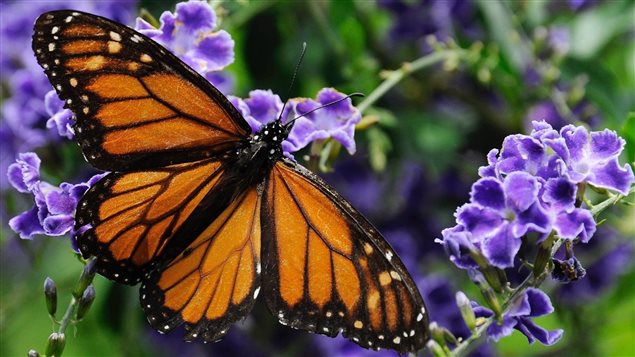Monarch butterflies are in peril. The population of the beautiful creatures has been devasted over the last 20 years and scientists at Montreal’s Space for Life, are asking Canadians to join the effort to save them.
“Mission Monarch” is the name of the initiative, launched last week. It is the combined effort of Canadian citizens and scientists to document the habitat of the butterfly here in Canada.
“We want the people, all Canadians, to give us a hand to improve their reproductive success all around the country.”
There are over a hundred people registered on the site already, and the goal is to create a major network of collaborators to report, ideally weekly, on the sightings of eggs and caterpillars, according to Max Larrivee, of Montreal’s Space for Life.
ListenMonarch butterflies once numbered over a billion in North America. Over the last 20 years a drastic decline reduced that number to 30 million two years ago. With careful attention the monarch population was restored to an estimated 60 million last year, and in March of this year they were believed to number around 100 million.
Larivvee says, however, a freak February snowstorm in Mexico destroyed or damaged some of that population, so careful observation of the migrating population back to Canada this summer is essential.
The goal is to have a “viable migratorial population that can withstand the pressures” Larrivee says. A population of about 250,000 monarchs is the eventual target.
Larrivee suggests people begin observing now, and start by counting the number of milkweed plants, which are the host plant for the monarch life cycle. It’s on milkweed plants the eggs are layed, and from there, the caterpillar and chrysalis follow.
Beginning the endeavour now, one can observe the devlopments as the butterflies are arriving back in Canada, from Mexico, these very days. Soon eggs will be evident on the milkweed and eventually, caterpillars.
Agricultural settings reduced
Along with the climate change that is bringing unprecedented and intense weather events, Larrivee says the changes in agricultural practices have also had a devastating effect on the monarch habitat.
This is why the count of the milkweed plant is so crucial. Larrivee says the plants used to grow in agricultural settings but that the use of systemic herbicides, in a effort to increase crop yields, had a dramatic effect on the milkweed and therefore, the number of monarchs that can reproduce in the fields.
Larrivee encourages families to get involved. He says monarch butterflies, or the caterpillars before them, are often “the first point of contact with nature for a lot of young ones.” He says it’s easy for people to get close to them, and the bonus he says, is that children can become aware of some of the things scientists do.







For reasons beyond our control, and for an undetermined period of time, our comment section is now closed. However, our social networks remain open to your contributions.